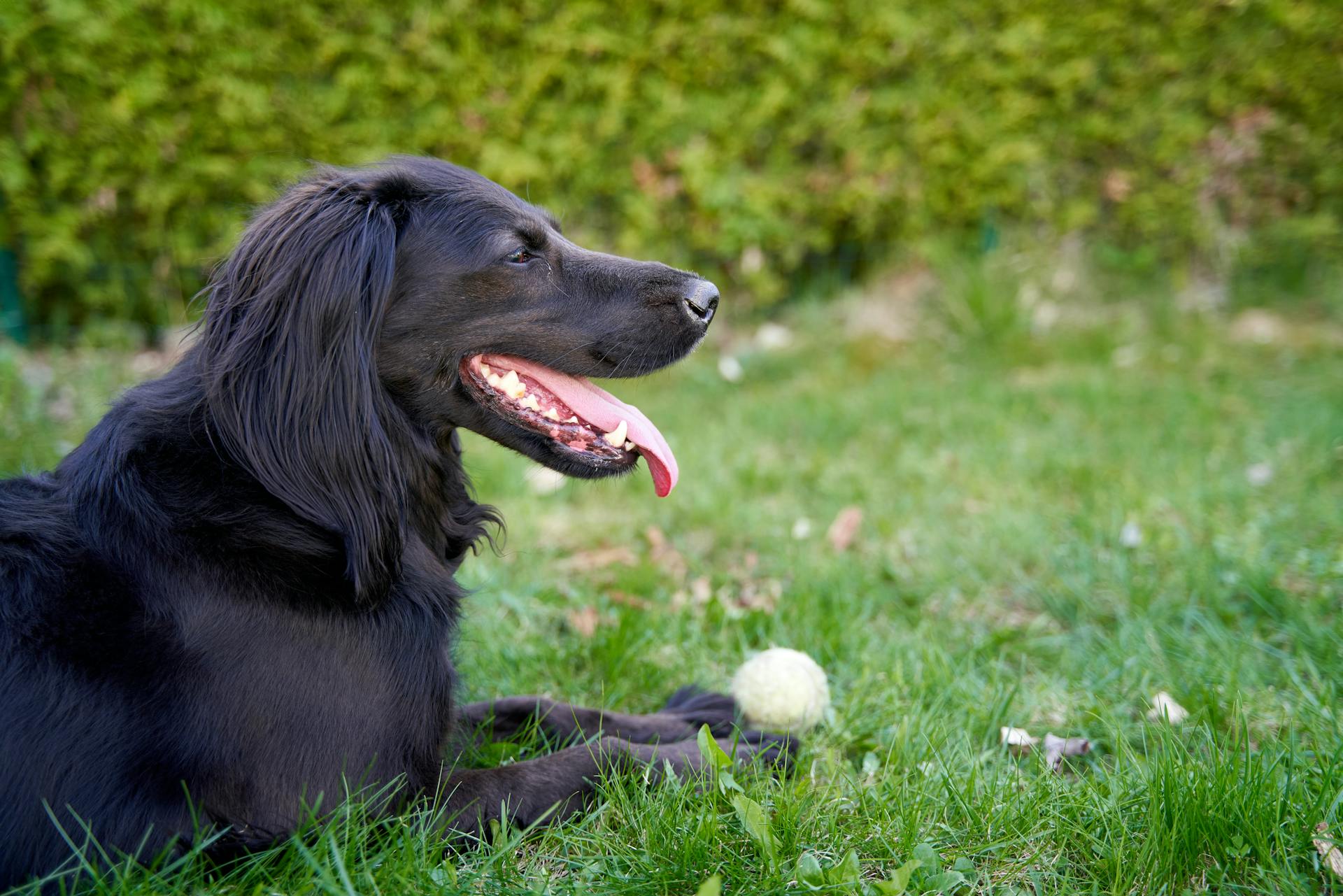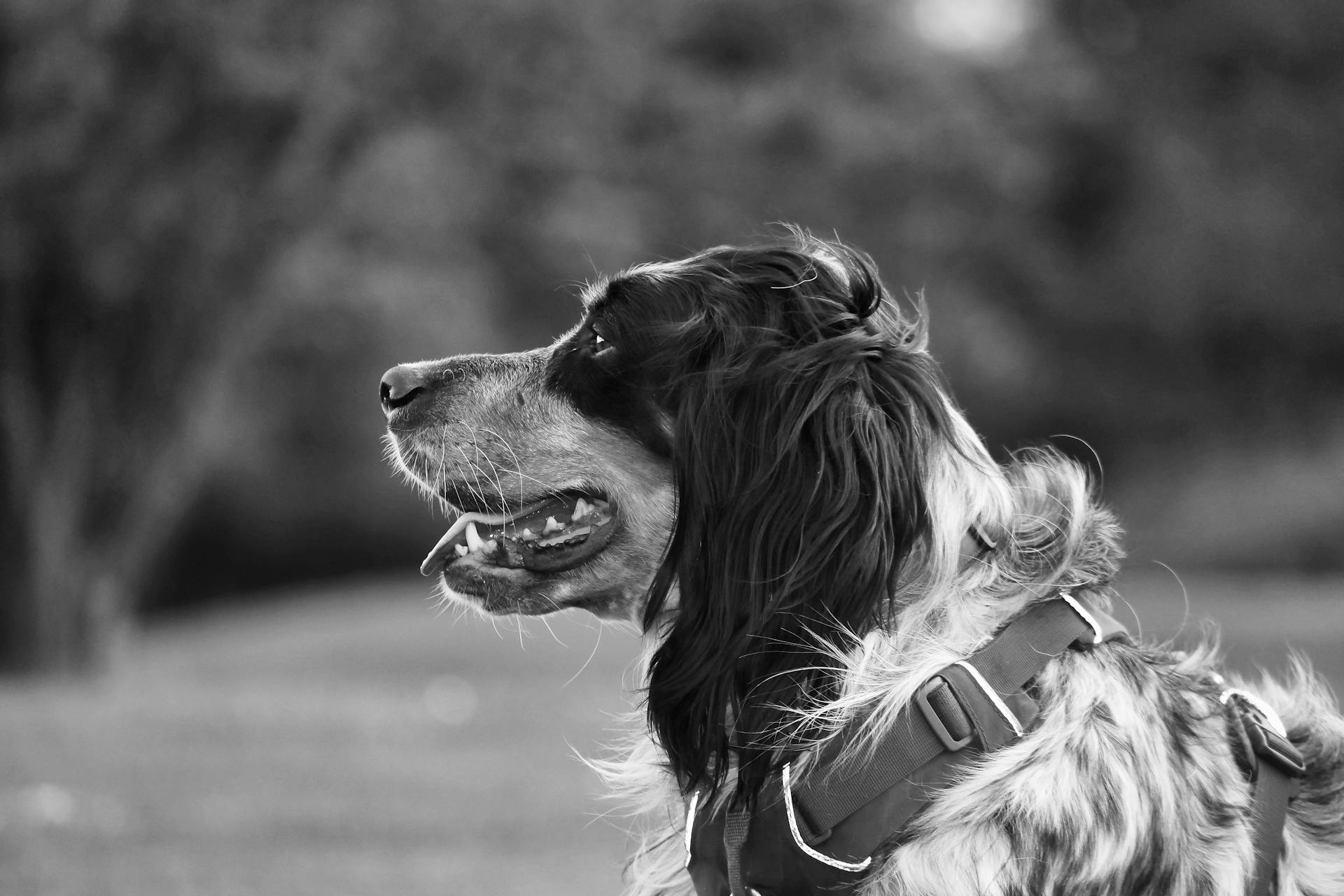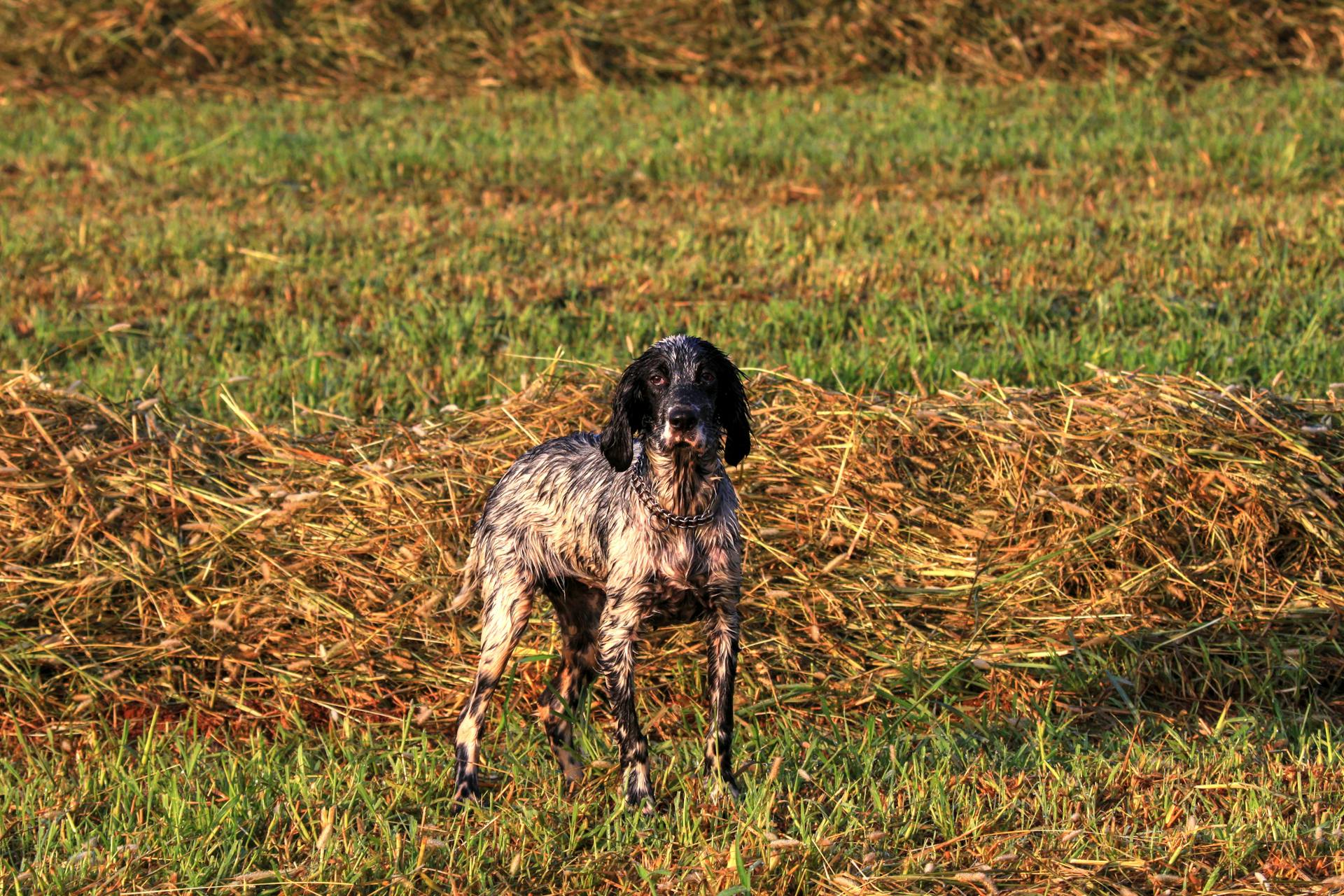
The Black and White English Setter is a stunning breed with a rich history. They originated in England in the 16th century as hunting dogs, bred to point and retrieve game.
Their distinctive black and white coat is a result of selective breeding for specific colors. This unique appearance has become a hallmark of the breed.
English Setters are known for their friendly and outgoing personalities, making them excellent family pets. With proper training, they are also great with children.
Breed Characteristics
English Setters are a beloved breed, and it's easy to see why. They're known for their gentle and affectionate nature, making them a great addition to families with children.
One of the most distinctive features of the English Setter is their coat. It can come in a wide variety of colors and patterns, including black and white. In fact, the Field Dog Stud Book defines a belton coat as "all white, but ticked with a secondary color or colors."
English Setters are also highly intelligent and trainable dogs, which makes them great for obedience and agility training. They're known for their exceptional hunting skills, particularly upland bird hunting.
Here are some key characteristics of the English Setter breed:
English Setters are also known for their high energy level and need regular exercise to stay happy and healthy. They're great companions for outdoor activities like hiking and running, and they thrive in active households.
Temperament & Intelligence
The black and white English Setter is a beautiful breed, and their temperament is just as striking. They are incredibly intelligent and loyal, making them a great companion for active families.
Their intelligence is one of their most notable traits, and they thrive on mental stimulation. This means they need plenty of interactive puzzles and outdoor games to keep their minds engaged.
English Setters are also highly energetic, which requires a lot of exercise to keep them happy and healthy. If they don't get enough physical activity, they can become bored and engage in mischievous behavior.
Their friendly nature makes them a great addition to any family, but it's essential to provide them with proper training and socialization from an early age. This will help them develop into well-rounded dogs that are confident and calm in new situations.
With patience, kindness, and consistency, you can raise a well-behaved and well-adjusted black and white English Setter that brings joy and companionship to your life.
Health and Care
English Setters are generally healthy, but like all breeds, they can be prone to certain health conditions. Hip dysplasia is a heritable condition where the thighbone doesn’t fit properly into the hip joint, and dogs with hip dysplasia should not be bred. Hip dysplasia can be screened for by the Orthopedic Foundation for Animals or the University of Pennsylvania Hip Improvement Program.
Hypothyroidism results from an abnormally low level of thyroid hormone production, and signs may include infertility, obesity, mental dullness, low energy levels, drooping eyelids, and irregular heat cycles. Hypothyroidism can be managed with daily medication throughout the dog’s life.
Worth a look: Hip Dysplasia Bernese Mountain Dog
To keep your English Setter healthy, it's essential to provide regular exercise and a balanced diet. A good schedule for providing your Setter puppy with exercise includes puppy kindergarten, obedience classes, and daily walks. Crate training can also help with housetraining and prevent destructive behavior when you're not home to supervise.
Here are some common health issues that can affect English Setters:
- Hip and elbow dysplasia: These health issues occur when the joints form abnormally, and can cause mobility issues and pain.
- Hypothyroidism: If your dog suffers from an underactive thyroid, their metabolism slows down, which can lead to a variety of symptoms.
- Deafness: Although not common, some English setters can be born deaf in one or both ears.
- Allergies: Environmental and food allergies are more common in English setters than in some breeds.
Size
The English Setter's size is a notable aspect of its overall health and care. Their medium to large-sized build requires regular exercise to maintain a healthy weight.
On average, male English Setters stand between 24 to 27 inches at the shoulder, while females are slightly smaller, ranging from 23 to 26 inches. This size range can affect the type and intensity of exercise they need.
Their weight typically falls between 55 to 80 pounds for males and 45 to 70 pounds for females, making them a relatively energetic breed. This energy level should be taken into account when planning their daily activities.
A different take: How Much Exercise Do Labrador Retrievers Need

Their well-balanced and sturdy frame is a testament to their athletic ability, which is essential for their hunting and fieldwork heritage. This athletic build also requires regular exercise to maintain its health and prevent obesity.
Their long, flowing coat requires regular grooming to prevent matting and tangling, but it's also a great way to bond with your English Setter during their daily care routine.
Health
English Setters are generally healthy dogs, but like any breed, they can be prone to certain health conditions. Hip dysplasia is a heritable condition where the thighbone doesn't fit properly into the hip joint. Dogs with hip dysplasia can develop arthritis as they age, and it's essential to obtain proof of health testing from the breeder before buying a puppy.
Hip dysplasia is often screened for by the Orthopedic Foundation for Animals or the University of Pennsylvania Hip Improvement Program. Dogs with hip dysplasia should not be bred to prevent the condition from being passed on to future generations.

Hypothyroidism is another common health issue in English Setters, resulting from an abnormally low level of thyroid hormone production. Signs of this condition may include infertility, obesity, mental dullness, and a coarse and brittle coat.
English Setters are also prone to deafness, which can be a challenging condition for both the dog and the owner. While some forms of hearing loss can be treated, most cases of deafness cannot be cured.
Elbow dysplasia is a heritable condition that affects the joints of English Setters, causing pain and lameness. Regular veterinary check-ups and early detection are crucial to managing this condition effectively.
Here are some common health issues to be aware of in English Setters:
- Hip and elbow dysplasia
- Hypothyroidism
- Allergies
- Congenital deafness
Care
English Setters thrive in company, so they're best suited to living in a household where they'll have companions for most of the day.
A fenced yard is a must for an English Setter, as they love to play and can get distracted by birds or other prey. They'll appreciate a good half-hour run off leash in a fenced area or a walk or hike on leash.

To prevent accidents, crate train your English Setter when they're young, and place them in their crate with a sturdy toy for entertainment when you can't supervise them. This will keep them out of trouble and your possessions in one piece.
English Setters can turn into couch potatoes around three years old, but they still need exercise to stay in shape. A good schedule for providing your Setter puppy with exercise includes puppy kindergarten, obedience classes, and daily walks.
To housetrain your English Setter, start early, keep them on a regular schedule, and reward them with praise or a treat when they potty outside. Crate them when you can't supervise them to prevent accidents.
Regular grooming is essential for English Setters, with a little more attention on their feathered features. A good rule of thumb is to keep them on a regular schedule, including daily walks and playtime.
Take a look at this: What Size Crate for an English Bulldog
Exercise and Training
English Setters are high-energy dogs that need at least an hour of daily exercise to stay happy and fit. They love to run, play, and explore, making them perfect companions for outdoor enthusiasts.
Long walks, hikes, and trips to the dog park are all great ways to keep your English Setter active and engaged. They're also natural athletes, so why not try setting up an agility course in your backyard or signing them up for a training course?
English Setters are highly trainable, responding well to reward-based methods. However, they're also sensitive souls, so harsh treatment or yelling is never a good idea.
Explore further: Why Are Labradors so Popular
Exercise
English Setters have a lot of energy, but they don’t have as much as other sporting breeds. They need an hour or more of daily exercise to stay fit and happy. You can take your pup on long walks, let them accompany you on hikes, bring them to the dog park, or play a game of tag or fetch in the backyard. They love to run around and get some fresh air.
They are quite athletic, which makes them great at sports competitions. You may want to sign them up for a training course or just set up an agility course in the backyard.
Training
English setters respond very well to reward-based training methods because they're eager to please. They thrive on positive reinforcement and attention.
Their gentle temperament means they can be sensitive to harsh treatment, so it's best to use gentle and patient training methods. This will help prevent them from becoming distressed.
Some English setters have a high prey drive due to their hunting background, which can make them prone to chasing small animals. This may require extra training to achieve a rock-solid recall.
You should work on rewarding quiet behavior to prevent alert barking from getting out of control. This will help your English setter become a well-behaved companion.
A fresh viewpoint: Shiba Inu $1
Grooming and Nutrition
The beautiful black and white English Setter! To keep their stunning coat looking its best, you'll want to brush them at least twice a week, if not more, with a soft-bristled brush or a metal comb with long teeth to work through tangled areas.
Regular ear checks are crucial to ensure your dog's ears are clean, and baths should be given every 4–6 weeks. Their nails need monthly trimming, and their teeth should be brushed a few times a week to prevent dental issues.
English Setters are moderate shedders, so a good weekly brush out is essential to keep their coat in good condition and prevent tangles, mats, or knots from developing in their feathering. Brushing their teeth at least a few times a week, if not daily, will also help prevent teeth and gum problems.
For more insights, see: English Bulldog Teeth
Diet and Nutrition
English Setters need high-quality food that's properly portioned to prevent overeating. Aim for 2 to 3 cups of food per day, divided into at least two meals.
Feeding your English Setter the right food is crucial, as they can be prone to developing allergies. Food-related allergies can trigger reactions, so it's essential to monitor their diet.
Keep an eye on your food and train your English Setter to leave you alone during dinnertime, as they love sneaking crumbs and food off countertops.
If this caught your attention, see: German Shorthaired Pointer and Allergies
Grooming
English Setters have a beautiful coat that requires regular grooming to prevent tangles and mats.
You should brush your English Setter at least twice a week, or more often if their hair is long, to keep their coat in good condition. A soft-bristled brush is a good choice, but you may also want to use a metal comb with long teeth to work through tangled areas.
Their feathering around the ears, feet, and legs needs regular trimmings to keep it neat. Check your dog's ears regularly to ensure they are clean, and give them a bath every 4-6 weeks.
English Setters are moderate shedders, so a good weekly brush out is essential to keep their coat in good condition. You can also trim some areas of their feathered coat or around the ears if needed.
Brushing your English Setter's teeth a few times a week can help prevent teeth and gum problems. Don't forget to trim their nails regularly, and check their ears for signs of infection or debris.
Expand your knowledge: 8 Week Old Yorkshire Terrier Puppy
Field Search
Field search is an essential aspect of the English Setter's nature. They were bred to search for game, and their strong prey drive makes them excellent at it.
If you're new to owning an English Setter, you might wonder how to encourage their natural hunting ability. According to Scott Berg, who's been breeding English Setters for over three decades, they can be soft to train, but that doesn't mean they're not trainable. With the right approach, they can be easier to train.
English Setters typically develop their pointing ability at a varying age, with some starting as early as eight weeks old and others taking up to 11 to 12 months. Regardless of when your Setter starts pointing, it's essential to remember that their pointing posture can vary depending on the region.
Traditionally, setters were expected to lay down on point, but in the UK, Scandinavia, France, and beyond, a more upright point is preferred. American English Setter breeders, on the other hand, require a "high on both ends" pointing style. Here's a breakdown of the different pointing styles:
By understanding the different pointing styles, you can better appreciate your English Setter's natural abilities and work with them to develop their skills.
Buying and Owning
Buying an English Setter can be a costly endeavor, with prices ranging from $1,000 for a pup from a breeder, regardless of pedigree.
To ensure you're getting a healthy, happy pup, seek out a reputable breeder who has done health checks on the parents and won't release the pups until they're at least 8 weeks old.
Buying from an irresponsible breeder can inadvertently support the puppy farming trade, so do your research and ask plenty of questions.
If you're prepared to give a dog the constant attention they require, a good place to start your search for a Black and White English Setter would be through the English Setter Association of America.
Expand your knowledge: American Staffordshire Bull Terrier Breeders
History
The English Setter has a rich history that spans over 400 years, with its origins dating back to England in the 15th century.
The breed's exact ancestry is unknown, but it's believed to be a cross between pointing and spaniel breeds, resulting in a dog that's more gentle and slightly smaller than the Irish Setter or Gordon Setter.

Artworks from the 15th century feature dogs that closely resemble the modern-day English Setter, showcasing its long history as a gun dog breed.
The breed's development in the 19th century was influenced by Edward Laverack and R. Purcell Llewellin, who bred English Setters with a focus on athletic physique, prominent feathering, and unique markings.
Laverack's line became known as the show-type, while Llewellin's line was developed for their field qualities, resulting in two distinct types of English Setters.
The first English Setter was imported to the United States in the 1870s, and the American Kennel Club recognized the breed in 1884.
English Setters are relatively rare, ranking 98th among breeds registered by the American Kennel Club, which means that those seeking to own one may need to be patient and join waiting lists before obtaining a puppy.
Consider reading: American Kennel Club Lancashire Heeler
Owning a Dog
Owning a dog is a large responsibility, and you'll need to know what to feed them, how to groom them, and what kinds of health issues they may face in the future.
You'll want to research the specific needs of the breed you're interested in, such as the English Setter, which requires constant attention.
Owning a dog requires a significant time commitment, so make sure you're prepared to spend time with your furry friend.
The cost of owning a dog can add up quickly, especially if you're buying from a breeder, where you can expect to pay around $1,000, regardless of pedigree.
Regular grooming is essential to prevent health issues and keep your dog looking their best.
If you're not prepared to give your dog the attention they need, you may want to reconsider getting one.
You should also consider the potential health issues your dog may face, such as those experienced by the English Setter breed.
It's essential to find a reputable breeder who has done health checks on the parents and raises the puppies in a home environment with their mother and other members of their litter.
Suggestion: When Is Best Time to Breed Dog
Frequently Asked Questions
What is a black and white setter called?
A black and white English Setter is referred to as a "blue belton". This is one of the valid combinations of the speckled coat colours in English Setters.
What are the two types of English Setters?
There are two types of English Setters: Laverack and Llewellin. The Llewellin is generally smaller and used for hunting, while the Laverack is larger and often preferred as a family pet.
What are the 4 breeds of Setters?
The four breeds of Setters are the English Setter, Gordon Setter, Irish Setter, and Irish Red and White Setter. These breeds are known for their distinctive characteristics and hunting abilities.
Which setter is the calmest?
English Setters are known for being the calmest of the setter breeds, making them a great choice for families who want a laid-back companion.
Is an English Setter a good house dog?
English Setters make great house dogs due to their gentle and affectionate nature. They thrive in most homes when properly cared for.
Featured Images: pexels.com


